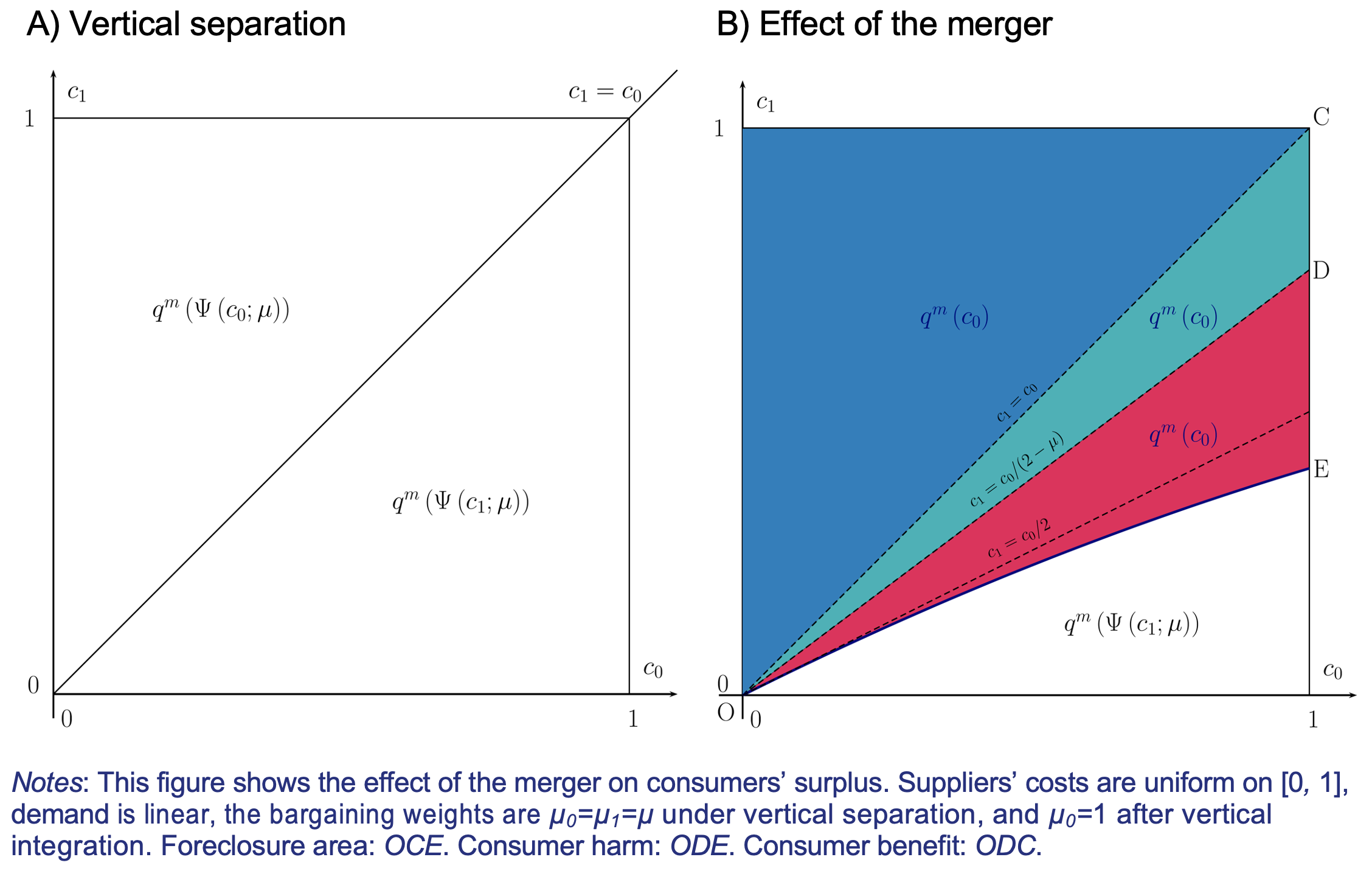The 2020 revision of the US Vertical Merger Guidelines, alongside high-profile legal battles, have thrust the intricate world of vertical integration into the spotlight.
A key aspect of these debates centres on the evaluation of efficiency claims, an aspect notably absent from earlier guideline versions. This discussion has rekindled interest in a classic economic concept – the elimination of double marginalisation (EDM).
Antitrust experts have debated whether consumers genuinely benefit from EDM, if these efficiency gains are truly unique to mergers, and the relationship between EDM and the potential market foreclosure resulting from vertical integration.
As early as 2018, the Federal Trade Commission (FTC) Bureau of Competition Director argued that vertical mergers, by eliminating double marginalisation, inherently promote competition through downward price pressure.
In contrast, in 2020, two FTC Commissioners challenged the notion that "vertical mergers often benefit consumers through EDM", and found the Guidelines overly optimistic about the positive effects of EDM in practice.
Many economists, among them Kwoka and Slade (2020), underlined that vertical integration is not always necessary to achieve the benefits of EDM and that the alleged gains of EDM are merger-specific only if they cannot be achieved by other (less socially costly) means. Traditional economic theory on EDM suggests a simple two-part pricing schedule as a solution, which does not inherently require a merger-specific approach.
A theoretical rationale for the elimination of double marginalisation
In our recent paper (Choné et al. 2023), we contribute to this ongoing debate by providing a theoretical rationale for merger-specific double marginalisation. Our analysis introduces the crucial element of asymmetric information about suppliers' costs into the equation. In this environment, conventional nonlinear pricing alone fails to eliminate double marginalisation when vertical separation persists.
More precisely, we consider a procurement environment characterised by competition and bargaining under conditions of asymmetric information. Here, an intermediary buyer operates within an upstream market and serves the demand of final consumers. This procurement process comprises two fundamental phases – a selection phase followed by a negotiation phase – mirroring common practices across various industries.
The buyer maximises her expected profit at the selection phase, anticipating the subsequent bargaining with the selected supplier. We do not restrict attention to any particular extensive-form bargaining game. We adapt the mechanism design approach of Loertscher and Marx (2022) to model the negotiation of price and quantity under asymmetric information.
We find that double marginalisation is part of the optimal mechanism – from the point of view of the buyer – and the extent of double marginalisation is inversely related to the bargaining power of the supplier. At the limit, with balanced bargaining power, asymmetric information ceases to matter and double marginalisation vanishes.
Are we returning to the Chicago school of thought?
In a sense, the Chicago narrative – that elimination of double marginalisation represents a merger-specific efficiency gain – is vindicated by the presence of asymmetric information when there is only one supplier. However, real-world procurement generally involves multiple suppliers, and vertical integration may hinder more efficient independent suppliers from participating.
Our research reveals that market foreclosure does occur in equilibrium, sparking the crucial question of its impact on final consumers. The replacement of a more efficient independent supplier by a less efficient internal one does not necessarily harm consumers because double marginalisation persists when the independent supplier is active.
Balancing elimination of double marginalisation and market foreclosure
We consider two symmetric suppliers, 0 and 1. By convention, if vertical integration takes place, the buyer merges with Supplier 0. Figure 1 summarises the consequences of vertical integration.
Figure 1 The effect of the merger on consumers’ surplus
Because the buyer does not know the suppliers’ costs, she has to leave informational rents to them. Under asymmetric information, the quantities sold are inversely related to the ‘virtual’ costs (represented by the Greek letter Ψ in Figure 1). Virtual costs exceed the real costs and decrease as the supplier's bargaining power increases. When a supplier wields as much power as the buyer, virtual and actual costs are equal, resulting in no DM under vertical separation.
Panel A of Figure 1 depicts the equilibrium under vertical separation in the cost space, assuming that the suppliers have identical cost distributions. The most efficient supplier delivers the product, and the contractual quantity is the monopoly quantity associated to the selected supplier’s virtual cost. Supplier selection is efficient, but double marginalisation endures (unless the selected supplier is as powerful as the buyer).
In Panel B of Figure 1, we depict the post-merger equilibrium. The buyer has acquired Supplier 0, and the merged entity maximises their joint profit. It is as if the acquired supplier’s bargaining power had been equalised with the buyer’s one.
In the OE1 area (the white area of Figure 1b), consumers are unaffected by vertical integration. This is because the independent supplier (Supplier 1) continues to sell the same quantity under both integration and separation. However, exploitation occurs: now that the buyer can threaten to procure in-house, Supplier 1 must offer better terms to the buyer.
The Chicago narrative applies when the acquired supplier is more efficient than the independent one (the blue area of Figure 1b). Supplier 0 sells – a scenario identical to vertical separation – resulting in the elimination of double marginalisation. Consumers benefit from the merger.
Market foreclosure occurs when the independent supplier would sell under vertical separation but is excluded after vertical integration (the OCE area of Figure 1b). Whether this harms consumers depends on the balance between EDM and market foreclosure.
When the acquired supplier is not significantly less efficient than the independent one (the emerald ODC area of Figure 1b), consumers benefit from the merger. EDM outweighs the productive inefficiency induced by vertical integration.
Conversely, the replacement of the independent supplier by a significantly less efficient Supplier 0 harms consumers through reduced quantities (the red ODE area of Figure 1b). Here, the productive inefficiency induced by the vertical integration outweighs the benefits of EDM.
To sum up, the exclusion of the independent supplier can either promote or hinder competition. In the latter case, the Chicago narrative falls short. Importantly, both the likelihood of anticompetitive foreclosure and the magnitude of consumer harm increase with the suppliers’ bargaining power.
Empirical literature and future research directions
While much of the empirical literature on vertical relationships relies on complete information and linear pricing, recent advances in the empirical bargaining literature (see Larsen 2021 and Larsen and Zhang 2021) on the one hand, and nonlinear pricing (see the recent survey by Perrigne and Vuong 2019) on the other, highlight the significance of asymmetric information. We believe that combining these two strands of literature can illuminate procurement environments with asymmetric information, potentially identifying suppliers' production costs and bargaining weights.
As antitrust authorities continue to grapple with the complexities of vertical mergers, it becomes increasingly clear that a one-size-fits-all approach may not suffice. The Chicago narrative is not obsolete but a closer examination of pre-merger negotiations is essential to evaluating the impact of vertical integration on consumer welfare within the context of double marginalisation and market foreclosure. Only through a nuanced understanding of these issues can policymakers make informed decisions that promote both competition and consumer interests in evolving markets.
References
Choné, P, L Linnemer and T Vergé (2023), "Double marginalization, market foreclosure, and vertical integration", CEPR Discussion Papers 18239 (forthcoming in the Journal of the European Economic Association).
Chopra, R (2020), “Dissenting Statement Regarding the Publication of Vertical Merger Guide- lines Commission”, Federal Trade Commission, 30 June.
Dobbelaere, S, G McCormack, D Prinz and S Sóvágó (2023), "Firm consolidation and labour market outcomes", VoxEU.org, 6 January.
Kwoka, J and M Slade (2020), "Second thoughts on double marginalization", Antitrust 34(51).
Larsen, B J (2021), "The efficiency of real-world bargaining: Evidence from wholesale used-auto auctions", Review of Economic Studies 88(2): 851-882.
Larsen, B and A Lee Zhang (2021), "Quantifying bargaining power under incomplete information: A supply-side analysis of the used-car industry", Available at SSRN 3990290.
Loertscher, S and L M Marx (2022), "Incomplete information bargaining with applications to mergers, investment, and vertical integration", American Economic Review 112(2): 616-649.
Perrigne, I and Q Vuong (2019), "Econometrics of auctions and nonlinear pricing", Annual Review of Economics 11: 27-54.
Slaughter, R K (2020), “Dissenting Statement”, In re FTC-DOJ Vertical Merger Guide-lines, Commission File No. P810034, Federal Trade Commission.






